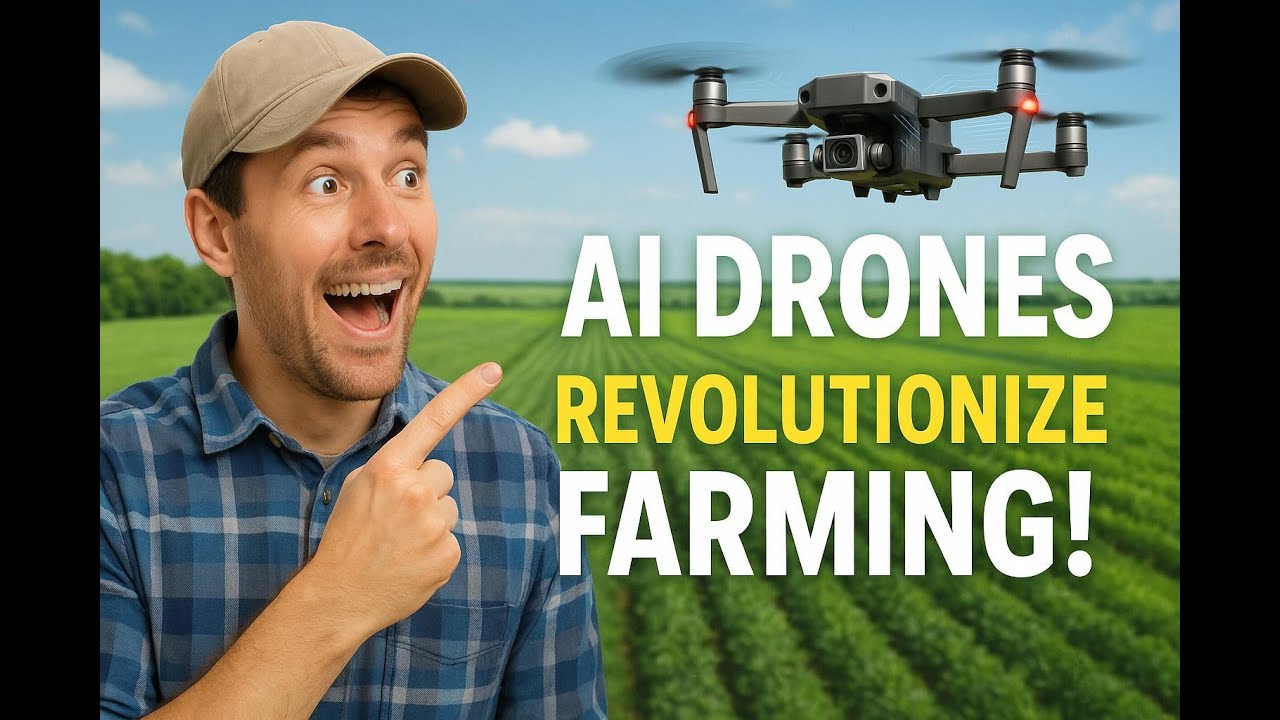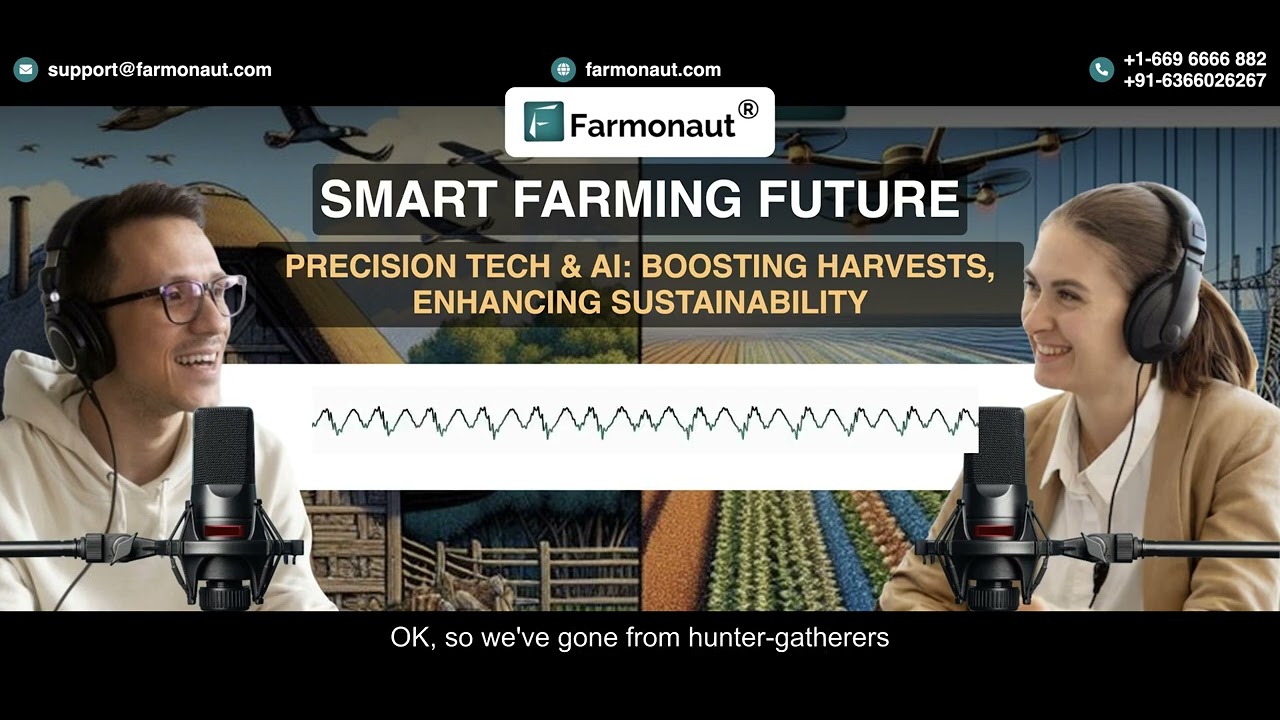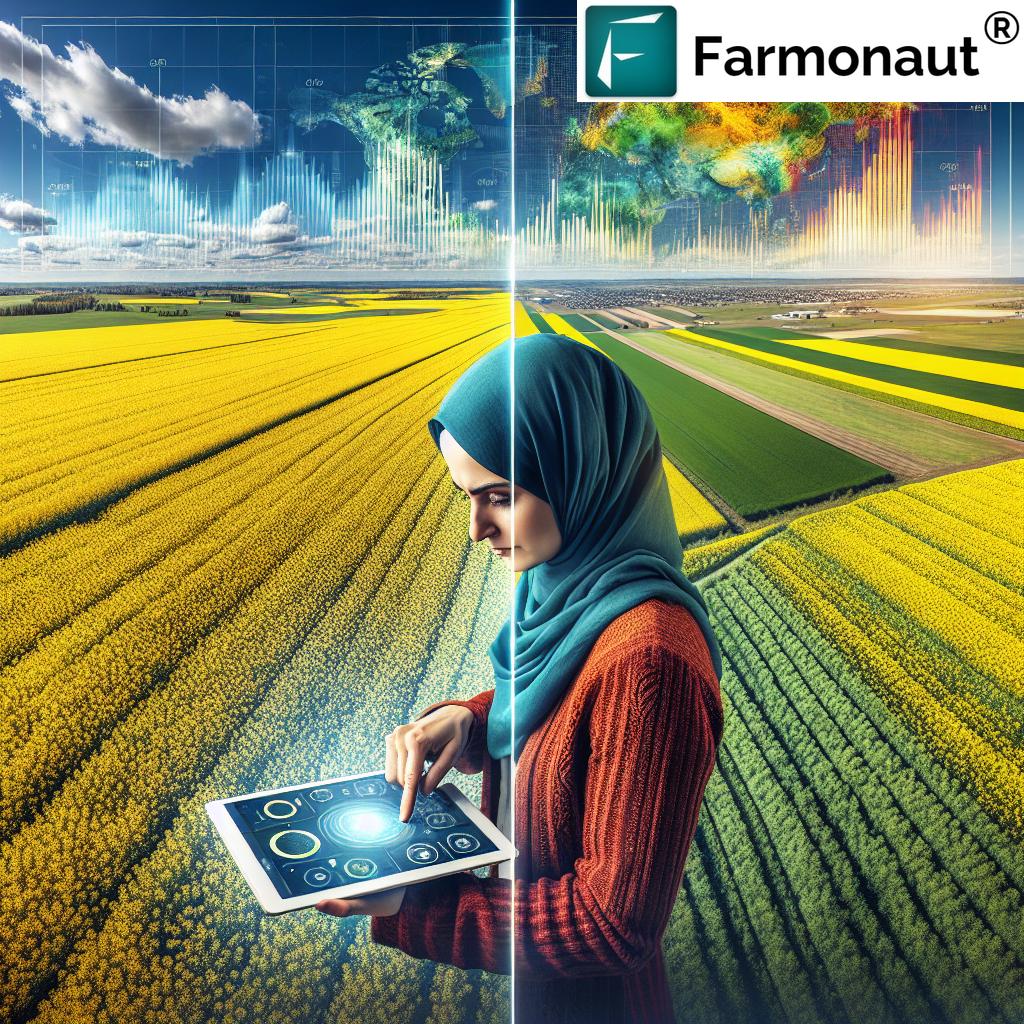AI and ML in Agriculture: 7 Trends Shaping CA 2025
“By 2025, AI and ML adoption in agriculture is projected to increase crop yields by up to 30% in California.”
“Over 60% of California farms are expected to use AI-driven resource management systems by 2025.”
Table of Contents
- Introduction: The Dawn of AI and ML in Agriculture
- Trend 1: Precision Agriculture and AI/ML-Driven Decisions
- Trend 2: Predictive Analytics for Climate and Yield Forecasting
- Trend 3: AI/ML-Enabled Pest and Disease Management
- Trend 4: Water Management & Precision Irrigation
- Trend 5: Advanced Robotics & Smart Mechanization
- Trend 6: AI & Data for Supply Chain and Market Optimization
- Trend 7: Sustainability, Environmental Stewardship, and Traceability
- Comparative Trend Impact Table (CA 2025)
- Farmonaut’s Role in Powering the Future of Agriculture
- FAQs: AI, ML, and the Future of Smart Agriculture
- Conclusion: Securing the Sustainable Agriculture of Tomorrow
Introduction: The Dawn of AI and ML in Agriculture
Artificial intelligence (AI) and machine learning (ML) are revolutionizing agriculture, ushering in a new era of smart farming defined by enhanced productivity, sustainability, and advanced resource management. As we approach 2025, the integration of AI and ML in agriculture is not just a technological upgrade—it’s a paradigm shift addressing the sector’s longstanding challenges like climate variability, resource optimization, and pest management. Nowhere is this transformation more visible, or more urgent, than in the dynamic agricultural regions of California.
By continuously harnessing AI and ML algorithms to analyze vast amounts of data from satellites, drones, IoT sensors, and weather stations, smart agriculture empowers farmers to monitor their fields in real-time and make precise, data-driven decisions. This leads to more efficient, sustainable practices that boost yields while protecting our environment—a crucial combination for food security and climate resilience.
With projections indicating a surge in adoption and impact by 2025, we’re witnessing how AI-powered smart farming is rapidly shaping the future of the CA food and agriculture sector. In this comprehensive guide, we’ll explore the seven major trends in AI and ML in agriculture—focusing on California’s pioneering role, global ramifications, and actionable strategies for farmers and agribusinesses.
Trend 1: Precision Agriculture and AI/ML-Driven Decisions
Focus Keyword: AI in Smart Agriculture
Precision agriculture harnesses artificial intelligence and machine learning to transform the way we cultivate crops. Instead of a “one-size-fits-all” approach, AI in smart agriculture enables the customization of farming practices to the unique needs of every field—even down to individual plant levels.
- Data Collection: AI / ML algorithms analyze satellite imagery, multispectral drone images, and IoT sensors that monitor soil moisture, nutrient content, crop health, and weather conditions.
- Decision Support: The data is processed using powerful algorithms that provide actionable insights—such as where to irrigate, how much fertilizer to apply, and when to sow or harvest crops.
- Targeted Interventions: By acting on these insights, farmers can reduce input waste, lower operational costs, and minimize environmental impact through sustainable practices.
For instance, Canadian growers are integrating smart sensors and satellite data to determine optimal planting densities and fertilization schedules, maximizing yields on every acre. As of 2025, we project that over 65% of large-scale farms in both California and Canada will operate using some form of precision agriculture bolstered by AI / ML systems.

Try the Farmonaut Web App for Satellite-Based Crop & Resource Monitoring
Example Applications:
- AI-based soil health assessment by analyzing nutrient and moisture levels remotely (sample use case: NDVI and soil monitoring tools).
- Farmonaut’s satellite-based monitoring for real-time vegetation health, supporting precise fertilization practices—learn more about large-scale farm management tools here—improve crop outcomes with automated insight!
- Adjusting irrigation schedules to avoid overuse of water—a critical resource in drought-prone climates (useful for both California and global smart farming systems).
Key Benefits of AI and ML in Agriculture for Precision Farming:
- Optimize inputs like water, fertilizer, and seeds for maximum yield and minimum waste
- Reduced environmental impact through tailored interventions
- Enhanced profitability and sustainability, helping farmers remain competitive
Trend 2: Predictive Analytics for Climate and Yield Forecasting
AI and ML in Agriculture: Predicting Weather, Crop Health & Yields
AI and ML-driven predictive analytics are game changers for farm planning and risk mitigation. By analyzing historical weather, real-time sensor inputs, and global market trends, sophisticated algorithms help predict shifts in climate, anticipate crop diseases, and estimate harvest volumes—invaluable for every stakeholder in the CA food and agriculture system.
- Weather and Climate Modeling: Machine learning models digest multi-year weather data, satellite-derived moisture levels, and temperature trends. The result: Accurate forecasts for rainfall, heatwaves, frosts, or drought scenarios—critical for California’s variable climate.
- Yield Prediction: By modeling input-output patterns across geographies and seasons, AI helps farmers and supply chains plan for surplus or deficit, lowering the risk of food shortages or wasteful overproduction.
- Resource Allocation: Real-time advisories inform sowing, irrigation, and harvesting schedules for optimal yields and reduced climate-associated risks.
Forecasting further supports:
- Market management and contract planning by agribusinesses
- Government agencies and financial institutions assessing risk or offering satellite-based crop loan and insurance eligibility
- Efficient resource allocation, supporting crop security in a changing world
Trend 3: AI/ML-Enabled Pest and Disease Management
Harnessing AI and ML in Agriculture for Sustainable Pest and Disease Control
Machine learning and AI models are revolutionizing pest and disease management by detecting, forecasting, and guiding response to field threats. Traditional scouting methods are increasingly replaced by technologies that can detect subtle changes in crop health—even before symptoms are visible to the naked eye.
- Visual Recognition: Cameras on drones and field robots collect thousands of high-definition images, processed by AI to identify early signs of diseases or pest outbreaks.
- Pattern Analysis: ML models compare image patterns to vast disease databases, delivering instant diagnosis and recommended action.
- Targeted Interventions: Early detection allows for timely, minimal use of chemicals, benefiting crop yield and biodiversity.
Additional benefits:
- Rapidly mapping pest spread and forecasting future outbreaks
- Minimizing pesticide use, supporting sustainable agriculture and food safety
- Reducing labor dependence for large-scale field scanning
Want to ensure authentic, pest-free product origins? Discover Farmonaut’s blockchain-based traceability and API for custom agricultural data integration.
Trend 4: AI and ML for Water Management & Precision Irrigation
Optimizing Critical Water Resources with AI in Smart Agriculture
Agriculture claims around 70% of the world’s freshwater use; in drought-prone regions like California, AI-powered water management has become a survival imperative. Advanced AI / ML models analyze soil moisture, evapotranspiration rates, crop water use, and weather forecasts to create precision irrigation schedules that conserve water, reduce energy input, and maintain crop health.
- Remote Monitoring: Smart sensors and satellites continuously measure soil moisture levels—offering up-to-the-minute irrigation recommendations.
- Dynamic Scheduling: Algorithms adjust irrigation schedules based on real-time data, reducing water waste and guarding against both overwatering and drought-induced stress.
- Integration: Combining weather forecasting tools with field data ensures water is only provided when and where it’s needed most.
Mobile Tools: Increasingly, platforms like Farmonaut’s mobile and web apps allow farmers to manage irrigation control and monitor resource use from smartphones or browsers—no matter their farm size.
Trend 5: Advanced Robotics & Smart Mechanization
AI, ML, and Robotics: Redefining Efficiency in the Agricultural Sector
Advances in robotics, AI, and ML are automating the most labor-intensive farm tasks—planting, weeding, pest control, and harvesting. AI-powered farm robots equipped with multispectral cameras and precision arms can navigate fields, analyze plant health, and act autonomously.
- Automated Planting & Weeding: ML algorithms distinguish between crops and weeds, enabling targeted removal and minimizing herbicide use.
- Smart Harvesting: AI-guided harvesters optimize timing based on crop ripeness detected by sensors and imagery, ensuring peak quality and yield.
- Labor Efficiency: Reducing reliance on manual labor directly addresses workforce shortages—a growing challenge in CA food and agriculture.
Fleet and resource management tools—such as those on Farmonaut’s platform—help track machinery, optimize routes, and manage field operations for even greater efficiency and operational cost savings.
Trend 6: AI & Data for Supply Chain and Market Optimization
Smart Systems: AI-Driven Supply Chain, Market Access, and Risk Management in Agriculture
AI and ML are also transforming agricultural supply chains by improving market forecasting, logistics management, and reducing food waste. Platforms equipped with real-time data feeds, blockchain-based traceability, and predictive analytics empower all participants—from field to market.
- Real-Time Demand Forecasting: AI models analyze weather, historic sales data, and even global trading patterns to predict market demand and supply, helping optimize harvest and distribution timelines.
- Blockchain Traceability: Blockchain-powered traceability systems (provided by platforms like Farmonaut) track produce from farm to table, enhancing food safety, quality assurance, and brand trust.
- Risk Assessment Tools: Farmers and agribusinesses can assess risks, access real-time pricing information, and make more informed selling decisions.
- Democratic Access: Digital platforms bridge the knowledge gap for smaller producers, offering advisory services and access to premium markets with a reduced risk of fraud.
Trend 7: Sustainability, Environmental Stewardship, and Traceability
AI & ML Elevate Sustainability in CA Food and Agriculture
Environmental sustainability and climate resilience are now commercial imperatives for all agricultural businesses—and AI / ML are the engines driving progress. Platforms use remote sensing, advanced analytics, and blockchain to:
- Monitor Carbon Footprint: Automated systems track carbon emissions, soil health, and biodiversity, helping farms comply with regulations and move towards net-zero targets.
- Support Regulatory Compliance: Automated environmental reporting tools minimize manual paperwork and help avoid non-compliance penalties.
- Enable Circular Economies: Smart waste management and recycling—powered by AI—support sustainable practices such as farm plastic recycling and nutrient cycling.
- Empower Stewardship: By reducing unnecessary agrochemical use and optimizing resource allocation, AI in smart agriculture fosters biodiversity and resilient ecosystems.
Did you know? By 2025, cutting-edge environmental monitoring can assist in carbon footprinting, compliance, and supply chain environmental stewardship more comprehensively than ever before.
“By 2025, AI and ML adoption in agriculture is projected to increase crop yields by up to 30% in California.”
“Over 60% of California farms are expected to use AI-driven resource management systems by 2025.”
Comparative Trend Impact Table (CA 2025)
This table visualizes how each of the 7 major AI/ML-driven trends impacts smart farming objectives in California by 2025. It covers adoption rate, yield improvement, resource optimization, and contributions to climate resilience, offering actionable insights and future projections.
| AI/ML Trend | Estimated Adoption Rate by 2025 (%) | Potential Yield Improvement (%) | Expected Reduction in Resource Usage (%) | Contribution to Climate Resilience (Qualitative/Estimated %) |
|---|---|---|---|---|
| Precision Agriculture & Smart Decision Systems | 65 | 20–28 | 15–22 | High (AI/ML enables real-time adaptation to climate variability) |
| Predictive Analytics for Climate & Yields | 72 | 12–18 | 10–16 | Medium-High (Faster climate impact forecasting) |
| Pest & Disease Management | 57 | 8–13 | 10–15 (fewer chemicals) | Medium (Resistant crop selection, disease outbreak mitigation) |
| Water Management/Precision Irrigation | 62 | 11–16 | 20–30 | High (Efficient water use strengthens resilience to drought) |
| Advanced Robotics & Automation | 33 | 7–12 | 8–14 | Medium (Reduces labor-related delays, supports adaptive responses) |
| AI Supply Chain & Market Analytics | 56 | 7–10 | 6–12 (reduces post-harvest loss) | Medium-High (Improved food security, market responsiveness) |
| Sustainability, Stewardship & Traceability | 45 | 5–9 | 7–10 | Very High (Supports long-term ecosystem health & compliance) |
Farmonaut’s Role in Powering the Future of Agriculture
At Farmonaut, we believe that the future of agriculture relies on unlocking the full potential of satellite technology and data-driven systems. Our mission is to democratize satellite-driven insights for every stakeholder—from smallholder farmers to government institutions—and empower smarter, more sustainable decisions.
With our platform, you can:
- Monitor crop health, soil moisture, and NDVI—using up-to-date satellite imagery accessible from Android, iOS, or Web App.
- Leverage real-time carbon footprint monitoring and blockchain-based traceability for compliance, transparency, and food chain security.
- Access satellite-verified advisory tools for crop loans and insurance—empowering financial access for the agriculture sector.
- Integrate field equipment management and logistics via our fleet management tools.
- Scale up to enterprise and institutional solutions using flexible APIs and robust developer documentation.
Whether supporting agroforestry or large-scale commercial farms, our Farmonaut large scale farm management suite delivers AI powered field analytics and advisory.
FAQs: AI, ML, and the Future of Smart Agriculture
-
What is the difference between AI and ML in agriculture?
Artificial intelligence (AI) is a broad field enabling machines to perform tasks that normally require human intelligence, while machine learning (ML) is a subset of AI that allows systems to learn from data patterns and improve over time—crucial for adaptive, data-driven farming systems.
-
How do AI and ML improve crop yields?
AI / ML optimize every stage of crop production by processing satellite, drone, sensor, and weather data. They help identify ideal planting times, required resources, timely irrigation, early problem detection, and optimized harvesting.
-
Are AI-driven farm solutions affordable to small farmers?
Many AI and ML tools—especially satellite-driven platforms like Farmonaut—are designed for affordability and accessibility, offering mobile access and tiered packages suitable for smallholders as well as enterprises.
-
What role does environmental sustainability play?
AI-powered monitoring and analytics help reduce chemical input, conserve water, enhance soil health, and support carbon tracking, making sustainability a measurable goal for every farm.
-
Can AI/ML eliminate all farming risks?
While no technology can eliminate every risk, AI and ML significantly reduce the impact of climate, pest, and market variability by helping farmers make faster, data-driven decisions.
Conclusion: Securing the Sustainable Agriculture of Tomorrow
The integration of AI and ML in agriculture is more than a technological leap—it is the cornerstone of a climate-resilient, efficient, and equitable food future. From California’s fertile valleys to the Canadian plains, AI / ML are empowering farmers to optimize resources, bolster sustainability, and thrive in a rapidly changing world.
Sustainable food security, environmental stewardship, and operational efficiency are within reach for those who embrace smart, data-powered agriculture. As we cross into 2025, the potential of AI and ML in CA food and agriculture has never been clearer, or more necessary—for our fields, our environment, and our communities.
Ready to join the revolution? Explore Farmonaut’s apps, APIs, and traceability solutions today, and take the first step toward the future of data-driven, sustainable agriculture.




















